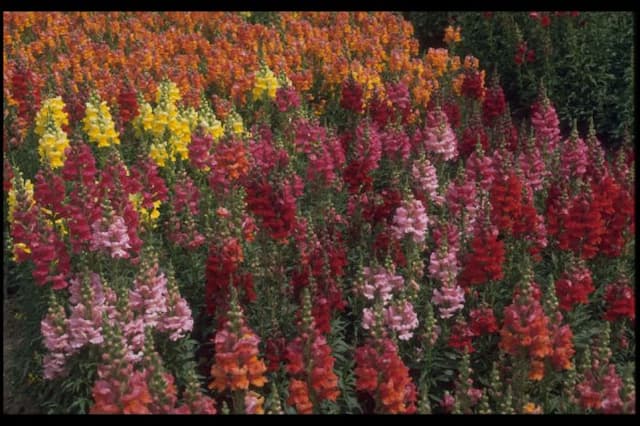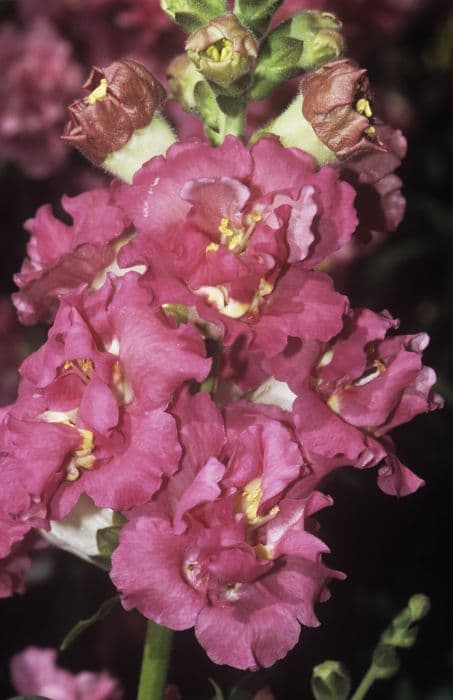Beard Tongue Penstemon 'Juicy Grape' (Ice Cream Series)

ABOUT
Penstemon 'Juicy Grape', belonging to the Ice Cream Series, is a flowering perennial plant renowned for its appealing looks. This variety has lush foliage, typically a vibrant green color, which creates an attractive backdrop for its striking flowers. The leaves are pointed and may have a slightly serrated edge. The standout feature of Penstemon 'Juicy Grape' is its abundant tubular blossoms that form along the upright flower spikes. These flowers possess a rich, grape-like purple hue, living up to the name 'Juicy Grape'. The inside of the flowers often has a paler tone with white or lighter purple striping, adding dimension and contrast. These blossoms attract pollinators such as bees and hummingbirds, adding to the lively and dynamic nature of the plant. The flowers themselves form dense clusters, creating a lush, colorful display that can be a showstopper in any garden. The overall shape of the plant is generally clumping, creating a mound-like presence in the landscape. While specific dimensions are not given, it's safe to say that 'Juicy Grape' would make a substantial contribution to garden beds and borders with its form and color. The overall aesthetic of the Penstemon 'Juicy Grape' is one of vibrant and long-lasting beauty, with its clear standout grape-purple flowers livening up any garden space where they are planted.
About this plant
 Names
NamesFamily
Plantaginaceae
Synonyms
Beardtongue, Juicy Grape Penstemon
Common names
Penstemon 'Juicy Grape'
 Toxicity
ToxicityTo humans
The Beardtongue plant is not known to be toxic to humans. However, as with any plant, individual allergic reactions or sensitivity can occur, so it is advisable to avoid ingestion and to handle plants with care if you have sensitive skin or known allergies. There are no widely recognized symptoms of poisoning associated with this plant as it is not considered poisonous.
To pets
The Beardtongue plant is not typically toxic to pets such as cats and dogs. It is not known to contain any substances that are poisonous to pets, so there should not be symptoms of poisoning. However, ingestion of any plant material can potentially lead to gastrointestinal upset in pets, so it is still best to prevent them from consuming plants.
 Characteristics
CharacteristicsLife cycle
Perennials
Foliage type
Deciduous
Color of leaves
Green
Flower color
Purple
Height
2-3 feet (60-90 cm)
Spread
1-2 feet (30-60 cm)
Plant type
Herb
Hardiness zones
7
Native area
North America
Benefits
 General Benefits
General Benefits- Attracts Pollinators: The vivid flowers of Beardtongue 'Juicy Grape' are known to attract bees, butterflies, and other beneficial insects to the garden.
- Drought Tolerant: Once established, it has low water requirements and can tolerate periods of drought, making it ideal for xeriscaping or water-wise gardens.
- Easy to Grow: This plant is generally easy to care for and can thrive in a variety of soil conditions as long as there is good drainage.
- Long Blooming: Beardtongue 'Juicy Grape' offers a long blooming season, providing color and interest in the garden from late spring to early summer.
- Deer Resistant: The foliage is not favored by deer, making it a good choice for areas where deer browsing is a problem.
- Aesthetic Appeal: With its rich purple flowers, it can be used as a striking addition to borders, container gardens, and as a focal point in landscape designs.
 Medical Properties
Medical PropertiesThis plant is not used for medical purposes.
 Air-purifying Qualities
Air-purifying QualitiesThis plant is not specifically known for air purifying qualities.
 Other Uses
Other Uses- Penstemons like 'Juicy Grape' can be used in dye production; their flowers may provide subtle shades and colors when used as a natural dye for fabrics.
- Papermaking enthusiasts could potentially incorporate the fibrous stems of penstemons to add texture and visual interest to handmade paper.
- The blossoms of 'Juicy Grape' penstemons can be pressed and used in botanical art pieces, such as framed nature crafts or decorative stationery.
- Plant enthusiasts might use the structured growth habit of penstemons for bonsai or miniature garden practices, shaping them into small-scale sculptures.
- Penstemons can be a natural way to teach children about botany and pollination, especially since they attract bees and hummingbirds.
- Penstemons’ tall, striking blooms can serve as a natural trellis for supporting and displaying climbing vines or vegetables in a garden.
- 'Juicy Grape' penstemons can be used in photography, offering a vibrant and colorful background or subject for botanical and garden photography.
- The flowers can be used in culinary presentations; while not widely regarded as edible, they can be utilized as ornamental garnishes for food plating.
- Educational institutions may use penstemons like 'Juicy Grape' for research on plant breeding, studying their genetic diversity and adaptability.
- Penstemons can be included in sensory gardens, where their various textures and colors can be used to stimulate the senses, especially sight and touch.
Interesting Facts
 Feng Shui
Feng ShuiThe Beardtongue is not used in Feng Shui practice.
 Plant Symbolism
Plant Symbolism- Attraction and Charm: The vibrant colors of the Penstemon 'Juicy Grape' flower symbolize an irresistible allure and charisma, much like its 'Juicy Grape' name implies, suggesting a draw to its beauty and an enchanting presence.
- Diversity and Versatility: As a member of the Ice Cream Series, Penstemon 'Juicy Grape' represents the variety and adaptability in nature, reflecting how it can thrive in different environments and appeal to a wide range of tastes.
- Emotional Expressiveness: The bold, grape-like hues of Penstemon 'Juicy Grape' stand for the openness and willingness to express one’s deepest feelings, encouraging communication of passions and sentiments.
- Garden Enhancement: This plant is often associated with the improvement and beautification of gardens, symbolizing growth, enhancement, and the continuous quest for aesthetic pleasure within our own living spaces.
- Endurance and Resilience: Penstemon, in general, is known for its hardiness and ability to withstand challenging conditions. The 'Juicy Grape' cultivar, with its vivacious color, echoes this sentiment of strength and the power to endure.
 Water
WaterBeardtongue requires moderate watering, aiming for a deep and thorough watering instead of frequent light spritzes. During the growing season, water the plant once a week with about one to two gallons of water, depending on the weather conditions. Make sure to allow the soil to dry out slightly between waterings to prevent root rot. During winter, reduce the watering frequency as the plant requires less moisture. It's crucial to water the plant at its base to keep the foliage dry and prevent fungal diseases.
 Light
LightBeardtongue thrives in full sun to partial shade. For the healthiest growth and best flower production, plant it in a location where it will receive at least six hours of direct sunlight daily, with some afternoon shade in extremely hot climates. Avoid deep shade locations, as this can lead to weak growth and fewer flowers.
 Temperature
TemperatureBeardtongue prefers temperate conditions and can generally withstand temperatures down to 20 degrees Fahrenheit. The ideal temperature range for this plant lies between 60 and 75 degrees Fahrenheit. It can tolerate summer heat well as long as there is adequate watering. Ensure that it's protected from harsh winter conditions, particularly in zones where temperatures can drop below its minimum tolerance.
 Pruning
PruningPrune beardtongue to remove any spent flowers or dead stems, and to encourage a bushy growth habit and more blooms. The best time to prune is after the first flush of flowers has faded, which is typically in late spring or early summer. Cut back by up to one-third of the plant's height to stimulate a second blooming period.
 Cleaning
CleaningAs needed
 Soil
SoilBeardtongue 'Juicy Grape' thrives in well-draining soil with a pH ranging from slightly acidic to neutral. An ideal soil mix can be created using equal parts of loam, peat, and coarse sand to ensure good drainage and aeration. It's essential to avoid heavy, clay-rich soils that retain water as this can lead to root rot.
 Repotting
RepottingBeardtongue 'Juicy Grape' does not need frequent repotting and can typically be repotted every 2 to 3 years to refresh the soil. It's best to repot in spring before the new growth starts. Choose a container only slightly larger than the existing one to prevent water-logging.
 Humidity & Misting
Humidity & MistingBeardtongue 'Juicy Grape' is tolerant of a wide range of humidity levels but prefers average room humidity. Excessively high humidity can promote fungal diseases, so ensure good air circulation if humidity levels are high.
 Suitable locations
Suitable locationsIndoor
Place in bright, indirect light and water thoroughly.
Outdoor
Full sun to partial shade in well-draining soil.
Hardiness zone
4-9 USDA
 Life cycle
Life cyclePenstemon 'Juicy Grape' begins its life cycle as a seed, which when planted and under the right conditions, will germinate and give rise to small seedlings. These seedlings grow into vegetative plants, characterized by the development of a rosette of basal leaves. As the plant matures, it enters the flowering stage, typically in late spring to early summer, producing tall spikes adorned with tubular, grape-colored flowers that attract pollinators such as bees and hummingbirds. After pollination, the flowers develop into seed capsules, which eventually dry and release seeds for the next generation. Throughout its life, the plant undergoes periods of active growth in the warmer months and enters a dormant phase during colder months, although as a perennial, the root system remains alive in the soil. The plant may live and continue this cycle for several years, with proper care and favorable conditions.
 Propogation
PropogationPropogation time
Spring to Summer
The most popular method for propagating Penstemon 'Juicy Grape' is through stem cuttings. To do this, one should take cuttings from new growth in late spring or early summer. Choose healthy, non-flowering stems and make a cut just below a node, about 4 to 6 inches (10 to 15 centimeters) in length. Strip the leaves from the bottom half of the cutting and dip the cut end into a rooting hormone powder to encourage root development. The cutting can then be planted in a moist potting mix, with the bottom half of the stem buried. Cover the pot with a plastic bag or place it in a propagator to maintain high humidity around the cutting. Roots typically develop within a few weeks, at which point the new plants can be acclimated to less humid conditions and eventually transplanted outside.





![Snapdragon [Pretty in Pink]](/_next/image?url=https%3A%2F%2Fplants-admin.emdemapps.com%2Fimages%2Fplants%2F%2Fimages%2F604b5cb3b5385.png&w=640&q=75)



